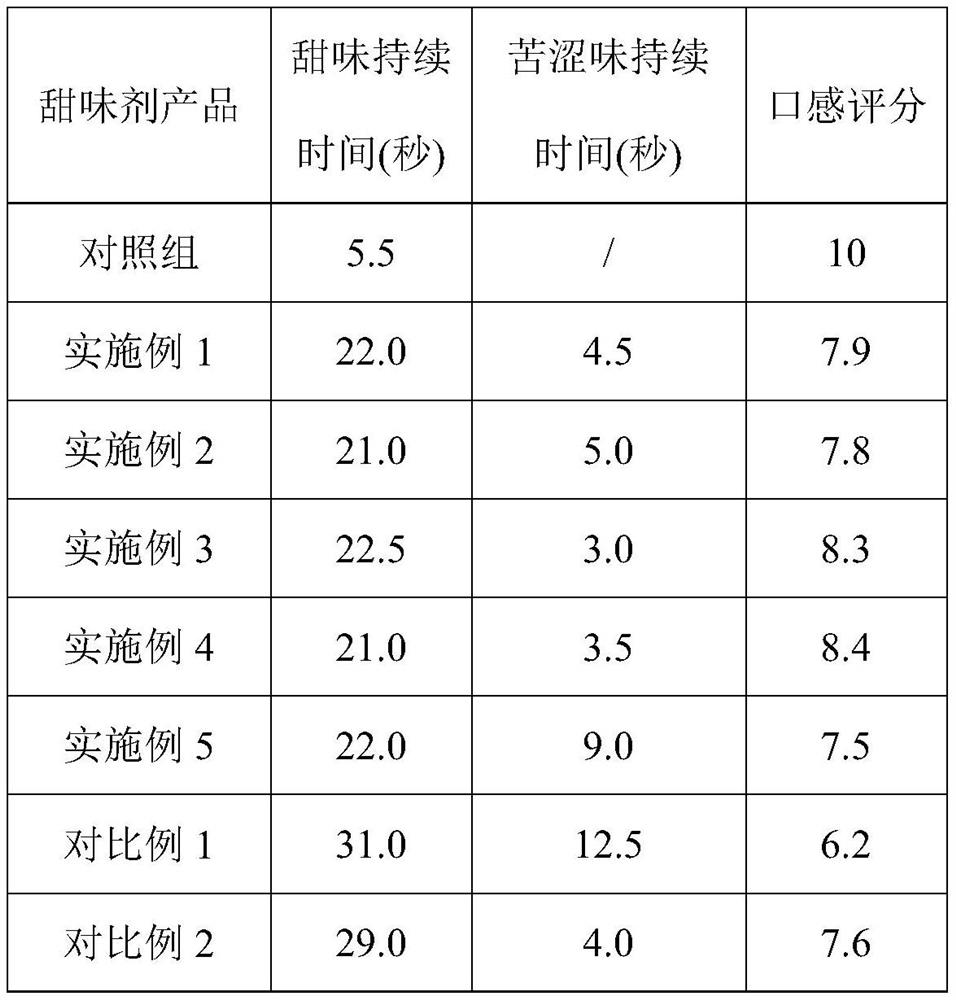A kind of sweetener for improving the taste of sweet tea glycosides and preparation method thereof
A technology of rubusoside and sweeteners, applied in the field of sweeteners and their preparations to improve the sweetness of rubusoside, which can solve the problems of removal steps or incomplete desalination, severe sweetness, post-sedimentation, etc., to improve the taste Taste, sweetness improvement, sweetness refreshing effect
- Summary
- Abstract
- Description
- Claims
- Application Information
AI Technical Summary
Problems solved by technology
Method used
Image
Examples
preparation example 1
[0061] Preparation Example 1 Crosslinking modification of LX-17 resin
[0062] Add 1kg of LX-17 resin, 3.5L of BCMB, and 12L of carbon tetrachloride into a stirred reaction kettle, let it stand for swelling for 10h, add 0.2kg of anhydrous zinc chloride, and react at 60°C for 12h under stirring conditions. After the reaction is completed, wash with absolute ethanol and deionized water until no precipitation is produced by adding nitrate solution to obtain chloromethylated LX-17 resin. The chloromethylated LX-17 resin was added to 12L of dewatered dimethyl sulfoxide to swell for 8h, 0.3kg of anhydrous aluminum chloride and 0.05kg of 1,4-cyclohexanediamine were slowly added, and the temperature was raised to 50 The reaction was carried out under stirring conditions for 12 h, filtered, washed with absolute ethanol and deionized water, respectively, until no precipitation was produced by adding the nitrate solution. The obtained resin was placed in a blast dryer, and vacuum-dried a...
preparation example 2
[0064] Preparation example 2 Crosslinking modification of DA-201 resin
[0065] Add 1kg of DA-201 resin, 3.5L of BCMB, 12L of carbon tetrachloride to a stirred reaction kettle, let it stand for swelling for 10h, add 0.2kg of anhydrous zinc chloride, and react at 60°C for 12h under stirring conditions. After the reaction is completed, wash with absolute ethanol and deionized water until no precipitation is produced by adding nitrate solution to obtain chloromethylated DA-201 resin. Chloromethylated DA-201 resin was added to 12L of dewatered dimethyl sulfoxide to swell for 6h, slowly added 0.3kg of anhydrous aluminum chloride and 0.08kg of triethylenetetramine, heated to 50°C under stirring conditions The reaction was carried out for 10 h, filtered, washed with absolute ethanol and deionized water, respectively, until no precipitation was produced by adding the nitrate solution. The obtained resin was placed in a blast dryer, and vacuum-dried at 60 °C overnight to obtain a cross...
Embodiment 1
[0068] (1) Decolorization: In advance, 80kg of LXD-200 resin was placed in a stainless steel chromatography column and treated with ethanol, 4% aqueous sodium hydroxide solution, and 4% hydrochloric acid according to the standard procedure of macroporous adsorption resin regeneration treatment before use. Take 10kg of 70% Rubusoside powder, add 170L of purified water, stir and dissolve, and then pass the dissolving solution through a chromatography column equipped with LXD-200 resin to collect the feed effluent; after feeding the material, add 160L of purified water to wash the resin column , collect the water wash. Combine the feed effluent and the water wash to obtain 320L of decolorized solution.
[0069] (2) Deacidification of phenol: 10kg of LX-17 resin was pre-packed in a stainless steel chromatography column and treated with ethanol, 4% aqueous sodium hydroxide solution and 4% hydrochloric acid according to the standard procedure of macroporous adsorption resin regenera...
PUM
 Login to View More
Login to View More Abstract
Description
Claims
Application Information
 Login to View More
Login to View More - R&D Engineer
- R&D Manager
- IP Professional
- Industry Leading Data Capabilities
- Powerful AI technology
- Patent DNA Extraction
Browse by: Latest US Patents, China's latest patents, Technical Efficacy Thesaurus, Application Domain, Technology Topic, Popular Technical Reports.
© 2024 PatSnap. All rights reserved.Legal|Privacy policy|Modern Slavery Act Transparency Statement|Sitemap|About US| Contact US: help@patsnap.com








